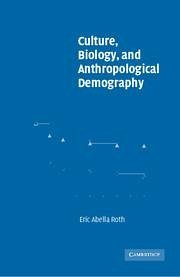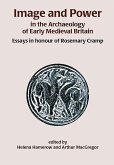Eric Abella Roth
Culture, Biology, and Anthropological Demography
Eric Abella Roth
Culture, Biology, and Anthropological Demography
- Broschiertes Buch
- Merkliste
- Auf die Merkliste
- Bewerten Bewerten
- Teilen
- Produkt teilen
- Produkterinnerung
- Produkterinnerung
Two distinctive approaches to the study of human demography exist within anthropology today--anthropological demography and human evolutionary ecology. Eric Roth reconciles these approaches through recognition of common research topics and the construction of a broad theoretical framework incorporating both cultural and biological motivation.
Andere Kunden interessierten sich auch für
![The Mass Media and the Dynamics of American Racial Attitudes The Mass Media and the Dynamics of American Racial Attitudes]() Paul M KellstedtThe Mass Media and the Dynamics of American Racial Attitudes64,99 €
Paul M KellstedtThe Mass Media and the Dynamics of American Racial Attitudes64,99 €![Homework Helpers: Biology, Revised Edition Homework Helpers: Biology, Revised Edition]() Matthew DistefanoHomework Helpers: Biology, Revised Edition16,99 €
Matthew DistefanoHomework Helpers: Biology, Revised Edition16,99 €![Megalithic Sites in Britain Megalithic Sites in Britain]() A. ThomMegalithic Sites in Britain207,99 €
A. ThomMegalithic Sites in Britain207,99 €![Image and Power in the Archaeology of Early Medieval Britain Image and Power in the Archaeology of Early Medieval Britain]() Image and Power in the Archaeology of Early Medieval Britain51,99 €
Image and Power in the Archaeology of Early Medieval Britain51,99 €![Anglo-Saxon Studies in Archaeology and History Anglo-Saxon Studies in Archaeology and History]() Anglo-Saxon Studies in Archaeology and History48,99 €
Anglo-Saxon Studies in Archaeology and History48,99 €![Anglo-Saxon Studies in Archaeology and History Anglo-Saxon Studies in Archaeology and History]() Anglo-Saxon Studies in Archaeology and History85,99 €
Anglo-Saxon Studies in Archaeology and History85,99 €![Geschichte Spaniens und Portugals zur Zeit der Herrschaft der Almoraviden und Almohaden, Erster Theil. Die Geschichte der Almoraviden, des castlischen Kaiserreiches und der Entstehung des Königreiches Portugal Geschichte Spaniens und Portugals zur Zeit der Herrschaft der Almoraviden und Almohaden, Erster Theil. Die Geschichte der Almoraviden, des castlischen Kaiserreiches und der Entstehung des Königreiches Portugal]() Joseph Von AschbachGeschichte Spaniens und Portugals zur Zeit der Herrschaft der Almoraviden und Almohaden, Erster Theil. Die Geschichte der Almoraviden, des castlischen Kaiserreiches und der Entstehung des Königreiches Portugal43,99 €
Joseph Von AschbachGeschichte Spaniens und Portugals zur Zeit der Herrschaft der Almoraviden und Almohaden, Erster Theil. Die Geschichte der Almoraviden, des castlischen Kaiserreiches und der Entstehung des Königreiches Portugal43,99 €-
-
-
Two distinctive approaches to the study of human demography exist within anthropology today--anthropological demography and human evolutionary ecology. Eric Roth reconciles these approaches through recognition of common research topics and the construction of a broad theoretical framework incorporating both cultural and biological motivation.
Hinweis: Dieser Artikel kann nur an eine deutsche Lieferadresse ausgeliefert werden.
Hinweis: Dieser Artikel kann nur an eine deutsche Lieferadresse ausgeliefert werden.
Produktdetails
- Produktdetails
- Verlag: Cambridge University Press
- Seitenzahl: 232
- Erscheinungstermin: 16. August 2004
- Englisch
- Abmessung: 224mm x 147mm x 13mm
- Gewicht: 318g
- ISBN-13: 9780521005418
- ISBN-10: 0521005418
- Artikelnr.: 21669379
- Herstellerkennzeichnung
- Libri GmbH
- Europaallee 1
- 36244 Bad Hersfeld
- gpsr@libri.de
- Verlag: Cambridge University Press
- Seitenzahl: 232
- Erscheinungstermin: 16. August 2004
- Englisch
- Abmessung: 224mm x 147mm x 13mm
- Gewicht: 318g
- ISBN-13: 9780521005418
- ISBN-10: 0521005418
- Artikelnr.: 21669379
- Herstellerkennzeichnung
- Libri GmbH
- Europaallee 1
- 36244 Bad Hersfeld
- gpsr@libri.de
Eric Abella Roth is Professor of Anthropology in the Department of Anthropology, University of Victoria, and an Affiliate, Center for Studies in Demography and Ecology, University of Washington-Seattle. He has conducted demographic anthropological fieldwork in the Canadian Subarctic, the Sudan and northern Kenya. He has published in various journals, including American Anthropology, American Journal of Physical Anthropology, Human Biology, Human Ecology, Journal of Anthropological Research, and Social Sciences and Medicine. He is co-editor of the text, African Pastoralist Systems: An Integrated Approach (1994, Lynne Rienner).
Part I. Anthropological Demography and Human Ecological Behavioural Ecology: 1. Two solitudes
2. Why bother?
3. Anthropological demography: culture, not biology
4. Human evolutionary ecology: biology, not culture
5. Discussion: cultural and biological reductionism
Part II. Reconciling Anthropological Demography and Human Evolutionary Ecology: 6. Common ground
7. Demographic strategies
8. Reproductive interests: social interactions, life effort and demographic strategies: a Rendille example
9. Sepaade as male mating effort
10. Rendille primogeniture as a parenting strategy
11. Summary: demographic strategies as links between culture and biology
Part III. Mating Effort and Demographic Strategies: 12. Mating effort as demographic strategies
13. Cross-cultural mating strategies: polygyny and bridewealth, monogamy and dowry
14. Bridewealth and the matter of choice
15. Demographic and cultural change: values and morals
16. The end of the sepaade tradition: behavioral tracking and moral change
Part IV. Demographic Strategies as Parenting Effort: 17. Parenting effort and the theory of allocation
18. The Trivers-Willard model and parenting strategies
19. Parity-specific parental strategies: the case of primogeniture
20. Local resource competition model
21. Infanticide and child abandonment: accentuating the negative
22. Adoption in modern China: stressing the positive
23. Summary: culture and biology in parental effort
Part V. Future Research Directions: 24. The central place of sex in anthropology and evolution
25. Male sexuality, education and high risk behavior
26. Final ground: demographic transitions
Part VI. References Cited.
2. Why bother?
3. Anthropological demography: culture, not biology
4. Human evolutionary ecology: biology, not culture
5. Discussion: cultural and biological reductionism
Part II. Reconciling Anthropological Demography and Human Evolutionary Ecology: 6. Common ground
7. Demographic strategies
8. Reproductive interests: social interactions, life effort and demographic strategies: a Rendille example
9. Sepaade as male mating effort
10. Rendille primogeniture as a parenting strategy
11. Summary: demographic strategies as links between culture and biology
Part III. Mating Effort and Demographic Strategies: 12. Mating effort as demographic strategies
13. Cross-cultural mating strategies: polygyny and bridewealth, monogamy and dowry
14. Bridewealth and the matter of choice
15. Demographic and cultural change: values and morals
16. The end of the sepaade tradition: behavioral tracking and moral change
Part IV. Demographic Strategies as Parenting Effort: 17. Parenting effort and the theory of allocation
18. The Trivers-Willard model and parenting strategies
19. Parity-specific parental strategies: the case of primogeniture
20. Local resource competition model
21. Infanticide and child abandonment: accentuating the negative
22. Adoption in modern China: stressing the positive
23. Summary: culture and biology in parental effort
Part V. Future Research Directions: 24. The central place of sex in anthropology and evolution
25. Male sexuality, education and high risk behavior
26. Final ground: demographic transitions
Part VI. References Cited.
Part I. Anthropological Demography and Human Ecological Behavioural Ecology: 1. Two solitudes
2. Why bother?
3. Anthropological demography: culture, not biology
4. Human evolutionary ecology: biology, not culture
5. Discussion: cultural and biological reductionism
Part II. Reconciling Anthropological Demography and Human Evolutionary Ecology: 6. Common ground
7. Demographic strategies
8. Reproductive interests: social interactions, life effort and demographic strategies: a Rendille example
9. Sepaade as male mating effort
10. Rendille primogeniture as a parenting strategy
11. Summary: demographic strategies as links between culture and biology
Part III. Mating Effort and Demographic Strategies: 12. Mating effort as demographic strategies
13. Cross-cultural mating strategies: polygyny and bridewealth, monogamy and dowry
14. Bridewealth and the matter of choice
15. Demographic and cultural change: values and morals
16. The end of the sepaade tradition: behavioral tracking and moral change
Part IV. Demographic Strategies as Parenting Effort: 17. Parenting effort and the theory of allocation
18. The Trivers-Willard model and parenting strategies
19. Parity-specific parental strategies: the case of primogeniture
20. Local resource competition model
21. Infanticide and child abandonment: accentuating the negative
22. Adoption in modern China: stressing the positive
23. Summary: culture and biology in parental effort
Part V. Future Research Directions: 24. The central place of sex in anthropology and evolution
25. Male sexuality, education and high risk behavior
26. Final ground: demographic transitions
Part VI. References Cited.
2. Why bother?
3. Anthropological demography: culture, not biology
4. Human evolutionary ecology: biology, not culture
5. Discussion: cultural and biological reductionism
Part II. Reconciling Anthropological Demography and Human Evolutionary Ecology: 6. Common ground
7. Demographic strategies
8. Reproductive interests: social interactions, life effort and demographic strategies: a Rendille example
9. Sepaade as male mating effort
10. Rendille primogeniture as a parenting strategy
11. Summary: demographic strategies as links between culture and biology
Part III. Mating Effort and Demographic Strategies: 12. Mating effort as demographic strategies
13. Cross-cultural mating strategies: polygyny and bridewealth, monogamy and dowry
14. Bridewealth and the matter of choice
15. Demographic and cultural change: values and morals
16. The end of the sepaade tradition: behavioral tracking and moral change
Part IV. Demographic Strategies as Parenting Effort: 17. Parenting effort and the theory of allocation
18. The Trivers-Willard model and parenting strategies
19. Parity-specific parental strategies: the case of primogeniture
20. Local resource competition model
21. Infanticide and child abandonment: accentuating the negative
22. Adoption in modern China: stressing the positive
23. Summary: culture and biology in parental effort
Part V. Future Research Directions: 24. The central place of sex in anthropology and evolution
25. Male sexuality, education and high risk behavior
26. Final ground: demographic transitions
Part VI. References Cited.








